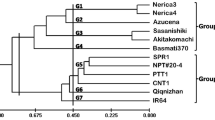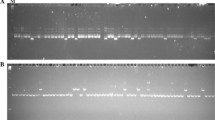Abstract
Two Cytoplasmic Male Sterile lines were crossed with fourteen restorer lines of rice widely grown in the western regions of Maharashtra, India, to produce 28 F1 hybrids which were evaluated for eight agronomically important traits, contributing to yield potential, in replicated field trials. The hybrid performance was recorded along with heterosis and heterobeltiosis. All the rice lines under investigation were subjected to marker-based variability analysis. An attempt was made to correlate genetic distance based on specific markers for each trait individually, as well as average genetic distance based on all specific markers, with hybrid performance and heterosis, by regression analysis. Specific markers could cluster the parental lines in different groups and showed significant correlation with hybrid performance. The data also supports the proposition that epistasis is the basis of heterosis. The analysis, however, revealed a lack of significant predictive values for field application.
Similar content being viewed by others
REFERENCES
Arcade, A., Faivre-Rampant, P., Le Guerroue, B., Paques, L. E., and Prat, D. (1996). Heterozygosity and hybrid performance in Larch. Theor. Appl. Genet. 93:1274-1281.
Barbosa-Neto, J. F., Sorrells, M. E., and Cisar, G. (1996). Prediction of heterosis in wheat using coefficient of parentage and RFLP based estimates of genetic relationship. Genome. 39:1142-1149.
Bernardo, R. (1992). Relationship between single-crosses performance and molecular marker heterozygosity. Theor. Appl. Genet. 83:628-634.
Boppenmaier, J., Melchinger, A. E., Brunklaus-Jung, E., Geiger, H. H., and Herrmann, R. G. (1993). Genetic distance for RFLPs in European maize inbreds. III, Performance of crosses within versus between heterotic groups for grain traits. Plant Breeding 111:217-226.
Cerna, F. J., Cianzio, S. R., Rafalski, A., Tingey, S., and Dyer, D. (1997). Relationship between seed yield heterosis and molecular marker heterozygosity in Soybean. Theor. Appl. Genet. 95:460-467.
Charcosset, A. (1992). Proc XIII EUCARPIA Cong. Springer, Berlin Heidelberg New York. 355-369.
Chowdari, K. V., Venkatachalam, S. R., Davierwala, A. P., Gupta, V. S., Ranjekar, P. K., and Govila, O. P. (1998). Hybrid performance and genetic distance as revealed by (GATA)4 microsatellite and RAPD markers in Pearlmillet. Theor. Appl. Genet. 97:163-169.
Deng, H., and Wang, G. (1984). A study on prediction of heterosis in crops (in chinese). Hunan Agric. Sci. 3:1-5.
Diers, B. W., McKetty, P. B. E., and Osborn, T. C. (1996). Relationship between heterosis and genetic distance based on restriction fragment length polymorphism markers in oilseed rape (Brassica napus L). Crop. Sci. 36:79-83.
Dudley, J. W., Saghai, Maroof, M. A., and Rufener, G. K. (1991). Molecular markers and grouping of parents in maize breeding programs. Crop. Sci. 31:718-723.
Eathington, S. R. (1997). Usefulness of marker-QTL association in early generation selection, Crop. Sci. 37:1686-1693.
Gimelfarb, A., and Lande, R. (1995). Marker assisted selection and marker-QTL associations in hybrid populations. Theor. Appl. Genet. 91:522-528.
Glaszmann, J. C. (1987). Isozyme and classification of Asian cultivated rice varieties. Theor. Appl. Genet. 74:21-30.
Godshalk, E. B., Lee, M., and Lankey, K. R. (1990). Relationship of restriction fragment length polymorphism in single-cross hybrid performance of maize. Theor. Appl. Genet. 80:273-289.
Griffing, B. (1956). Concept of general and specific combining ability in relation to diallel crossing system. Aust. J. Biol. Sci. 9:463-493.
Gupta, V. S., Ramakrishna, W., Rawat, S. R., and Ranjekar, P. K. (1994). (CAC)5 detects DNA finger-prints and sequences homologous to gene transcripts in rice. Biochem. Genet. 32:1-8.
Joshi, S. P., Gupta, V. S., Aggarwal, R. K., Ranjekar, P. K., and Brar, D. S. (2000). Genetic diversity and phylogenetic relationship as revealed by inter simple sequence repeat polymorphism in the genus Oryza. Theor. Appl. Genet. 100:1311-1320.
Lee, M., Godshalk, E. B., Lamkey, K. R., and Woodman, W. W. (1989). Association of restriction fragment length polymorphism among maize inbreds with agronomic performance of their crosses. Crop. Sci. 29:1067-1071.
Li, Z. B., Xiao, Y. H., Zhu, Y. H., Li, R. Q., Liu, C. L., and Wang, J. M. (1982). The study and practice of hybrid rice (in Chinese). Shanghai Academic and Technical press, Shanghai, China.
McCouch, S. R., Chen. X., Panaud, O., Temnykh, S., Xu, Y., Cho, Y. G., Huang, N., Ishii, T., and Blair, M. (1997). Microsatellite marker development, mapping and applications in rice genetics and breeding. Plant Mol. Biol. 35:89-99.
Mahalanobis, P. C. (1936). On the generalized distance in statistics. Proc. Nat. Inst. Sci. India 2(1):49-55.
Martin, J. M., Talbert, L. E., Lanning, S. P., and Blake, N. K. (1995). Hybrid performance in wheat as related to parental diversity. Crop. Sci. 35:104-108.
Melchinger, A. E., Lee, M., Lamkey, K. R., and Woodman, W. W. (1990a). Genetic diversity for restriction fragment length polymorphisms, relation to estimated genetic effects in maize inbreds. Crop. Sci. 30:1033-1040.
Melchinger, A. E., Lee, M., Lamkey, K. R., Hallaue, A. R., and Woodman, W. W. (1990b). Genetic diversity for restriction fragment length polymorphisms and heterosis for two diallel sets of maize inbreds. Theor. Appl. Genet. 80:488-496.
Melchinger, A. E., Boppenmaier, J., Dhillon, B. S., Pollmer, W. G., and Hermann, R. G. (1992). Genetic diversity for RFLPs in European maize inbreds: II. Relation to performance of hybrids within versus between heterotic groups for forage traits. Theor. Appl. Genet. 84:672-681.
Nei, M. (1987). Molecular evolutionary genetics. Columbia University Press, New York.
Parsons, B. J., Newbary, H. J., Jackson, M. T., and Ford-Loyd, B. V. (1997). Contrasting genetic diversity relationships are revealed in rice (Oryza sativa L.) using different marker types: Mol. Breeding 3:115-125.
Peng, J. Y., Glaszmann, J. C., and Virmani, S. S. (1988). Heterosis and isozyme diversions in Indica rice. Crop. Sci. 28:561-563.
Peng, J. Y., Virmani, S. S., and Julfiquar, A. W. (1991). Relationship between heterosis and genetic divergence in rice. Oryza 28:129-133.
Ramakrishna, W., Chowdari, K. V., Lagu, M. D., Gupta, V. S., and Ranjekar, P. K. (1995). DNA fingerprinting to detect genetic variation in rice using hypervariable DNA sequences. Theor. Appl. Genet. 90:1000-1006.
Ramakrishna, W., Lagu, M. D., Gupta, V. S., and Ranjekar, P. K. (1994). DNA fingerprinting in rice using oligonucleotide probes specific for simple repetitive DNA sequences. Theor. Appl. Genet. 88:402-406.
Ribaut, J.-M., and Hoisington, D. (1998). Marker assisted selection: New tools and strategies. Trends in Plant Sciences 3 6:236-239.
Rogers, S. O., and Bendich, A. J. (1988). Plant Molecular Biology Manual A6: 1 Ed. Gelvin, S. B. and Schilperoort, R. A., Kulwer Academic Publishers, Dordrecht.
Saghai Maroof, M. A., Yang, G. P., Zhang, Q., and Gravois, K. A. (1997). Correlation between molecular marker distance and hybrid performance in U S southern long grain rice. Crop. Sci. 37:145-150.
Sant, V. J., Patankar, A. G., Gupta, V. S., Sarode, N. D., Mhase, L. B., Sainani, M. N., Deshmukh, R. B., and Ranjekar, P. K. (1999). Potential of DNA markers in detecting divergence and in analyzing heterosis in Indian chickpea cultivars. Theor. Appl. Genet. 98:1217-1225.
Smith, O. S., Smith, J. S. C., Bowen, S. L., Tenborg, R. A., and Wall, S. J. (1990). Similarities among a group of elite maize inbreds as measured by pedigree, F1 grain yield, grain yield heterosis and RFLPs. Theor. Appl. Genet. 80:833-840.
Stuber, C. W., Lincoln, S. E., Wolff, D. W., Helentjaris, T., and Lander, E. S. (1992). Identification of genetic factors contributing to heterosis in a hybrid from two elite maize inbred lines using molecular markers. Genetics 132:823-839.
Swartz, D. (1989). Users manual, Information resource group, Maryland Biotechnology Institute, University of Maryland, College park, MD 20742 USA.
Virmani, S. S. (1994). Prospects of hybrid rice in the tropics and subtropics. In “Hybrid Rice Technology: New developments and future prospects” (Virmani, Ed.), pp 7-19, Int. Rice Res. Inst., Manila Philippines.
Wang, Z. W., and Tanksley, S. D. (1989). Restriction fragment length polymorphism in rice (Oryza sativa L) Genome. 32:1113-1118.
Yu, L. X., and Nguyen, H. T. (1994). Theor. Appl. Genet. 87:668-672.
Yu, S. B., Li, J. X., Xu, C. G., Tan, Y. F., Gao, Y. J., Li, H. X., Zhang, Q., and Saghai Maroof, M. A. (1997). Importance of epistasis as the genetic basis of heterosis in an elite rice hybrid. Proc. Natl. Acad. Sci. USA 94:9226-9231.
Xiao, J., Li, J., Yuan, L., and Tanksley, S. D. (1995). Dominance is the major genetic basis of heterosis in rice as revealed by QTL analysis using molecular markers. Genetics 140:745-754.
Xiao, J., Li, J., Yuan, L., McCouch, S. R., and Tanksley, S. D. (1996). Genetic diversity and its relationships to hybrid performance and heterosis in rice as revealed by PCR-based markers. Theor. Appl. Genet. 92:637-643.
Zhang, Q. F., Zhou, Z. Q., Yang, G. P., Xu, C. G., Liu, K. D., and Saghai Maroof, M. A. (1996). Molecular marker heterozygosity and hybrid performance in Indica and Japonica rice. Theor. Appl. Genet. 93:1218-1224.
Zhang, Q. F., Gao, Y. J., Yang, S. H., Saghai Maroof, M. A., and Li, J. N. (1995). Molecular divergence and hybrid performance in rice. Mol. Breed. 1:133-142.
Zhang, Q. F., Gao, Y. J., Yang, S. H., Ragab, R. A., Saghai Maroof, M. A., and Li, Z. B. (1994). A diallele analysis of heterosis in elite hybrid rice based on RFLPs and microsatellites. Theor. Appl. Genet. 89:185-192.
Author information
Authors and Affiliations
Corresponding author
Rights and permissions
About this article
Cite this article
Joshi, S.P., Bhave, S.G., Chowdari, K.V. et al. Use of DNA Markers in Prediction of Hybrid Performance and Heterosis for a Three-Line Hybrid System in Rice. Biochem Genet 39, 179–200 (2001). https://doi.org/10.1023/A:1010293325482
Issue Date:
DOI: https://doi.org/10.1023/A:1010293325482




